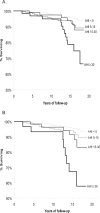Sleep disordered breathing and mortality: eighteen-year follow-up of the Wisconsin sleep cohort
- PMID: 18714778
- PMCID: PMC2542952
Sleep disordered breathing and mortality: eighteen-year follow-up of the Wisconsin sleep cohort
Abstract
Background: Sleep-disordered breathing (SDB) is a treatable but markedly under-diagnosed condition of frequent breathing pauses during sleep. SDB is linked to incident cardiovascular disease, stroke, and other morbidity. However, the risk of mortality with untreated SDB, determined by polysomnography screening, in the general population has not been established.
Methods: An 18-year mortality follow-up was conducted on the population-based Wisconsin Sleep Cohort sample (n = 1522), assessed at baseline for SDB with polysomnography, the clinical diagnostic standard. SDB was described by the number of apnea and hypopnea episodes/hour of sleep; cutpoints at 5, 15 and 30 identified mild, moderate, and severe SDB, respectively. Cox proportional hazards regression was used to estimate all-cause and cardiovascular mortality risks, adjusted for potential confounding factors, associated with SDB severity levels.
Results: All-cause mortality risk, adjusted for age, sex, BMI, and other factors was significantly increased with SDB severity. The adjusted hazard ratio (HR, 95% CI) for all-cause mortality with severe versus no SDB was 3.0 (1.4,6.3). After excluding persons who had used CPAP treatment (n = 126), the adjusted HR (95% CI) for all-cause mortality with severe versus no SDB was 3.8 (1.6,9.0); the adjusted HR (95% CI) for cardiovascular mortality was 5.2 (1.4,19.2). Results were unchanged after accounting for daytime sleepiness.
Conclusions: Our findings of a significant, high mortality risk with untreated SDB, independent of age, sex, and BMI underscore the need for heightened clinical recognition and treatment of SDB, indicated by frequent episodes of apnea and hypopnea, irrespective of symptoms of sleepiness.
Figures

Comment in
-
Does untreated obstructive sleep apnea lead to death? A commentary on Young et al. Sleep 2008;31:1071-8 and Marshall et al. Sleep 2008;31:1079-85.Sleep. 2008 Aug;31(8):1067-8. Sleep. 2008. PMID: 18714776 Free PMC article. No abstract available.
References
-
- Somers VK, White DP, Amin R, et al. Sleep apnea and cardiovascular disease: American Heart Association Scientific Statement. Circulation. 2008. Epub June 17. - PubMed
-
- Krieger J, McNicholas WT, Levy P, et al. Public health and medicolegal implications of sleep apnoea. Eur Respir J. 2002;20:1594–609. - PubMed
-
- Colten HR, Altevogt BM, editors. Washington DC: Institute of Medicine /National Academies Press; 2006. Sleep disorders and sleep deprivation: an unmet public health problem/Committee on Sleep Medicine and Research. Board on Health Sciences Policy; pp. 20–32. - PubMed
-
- Young T, Peppard PE, Taheri S. Excess weight and sleep-disordered breathing. J Appl Physiol. 2005;99:1592–9. - PubMed
Publication types
MeSH terms
Grants and funding
LinkOut - more resources
Full Text Sources
Other Literature Sources
Medical
